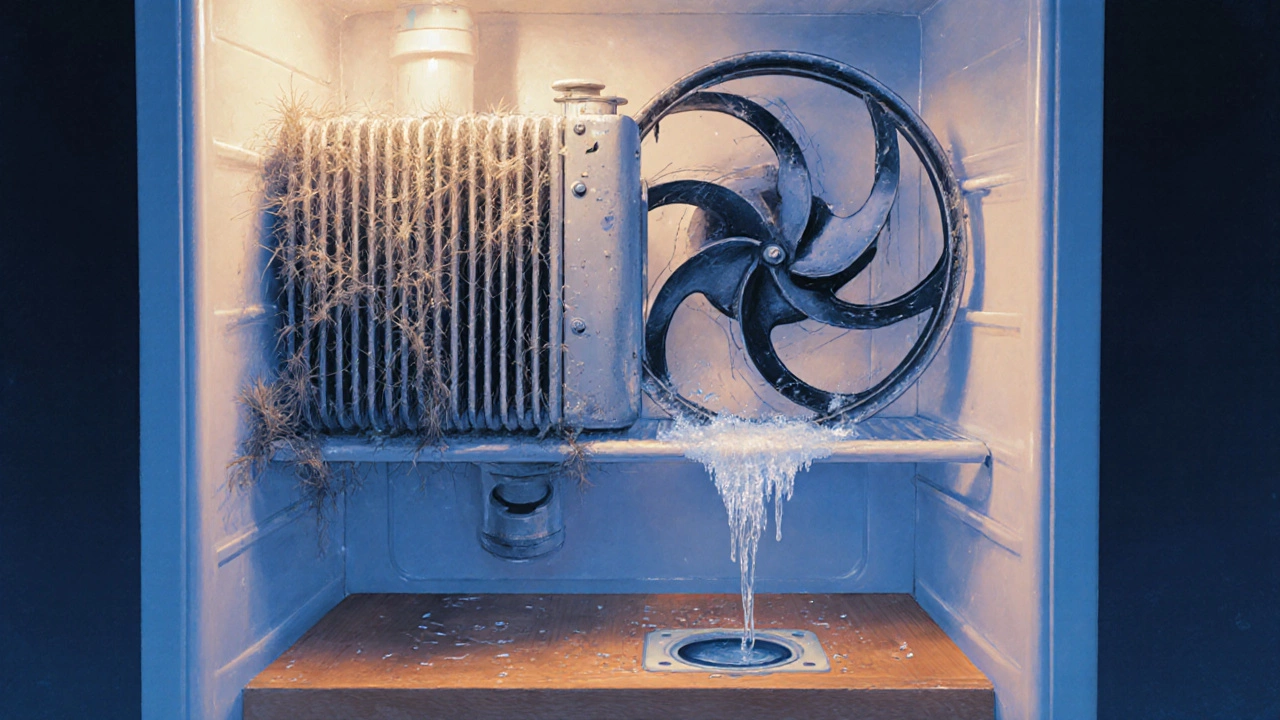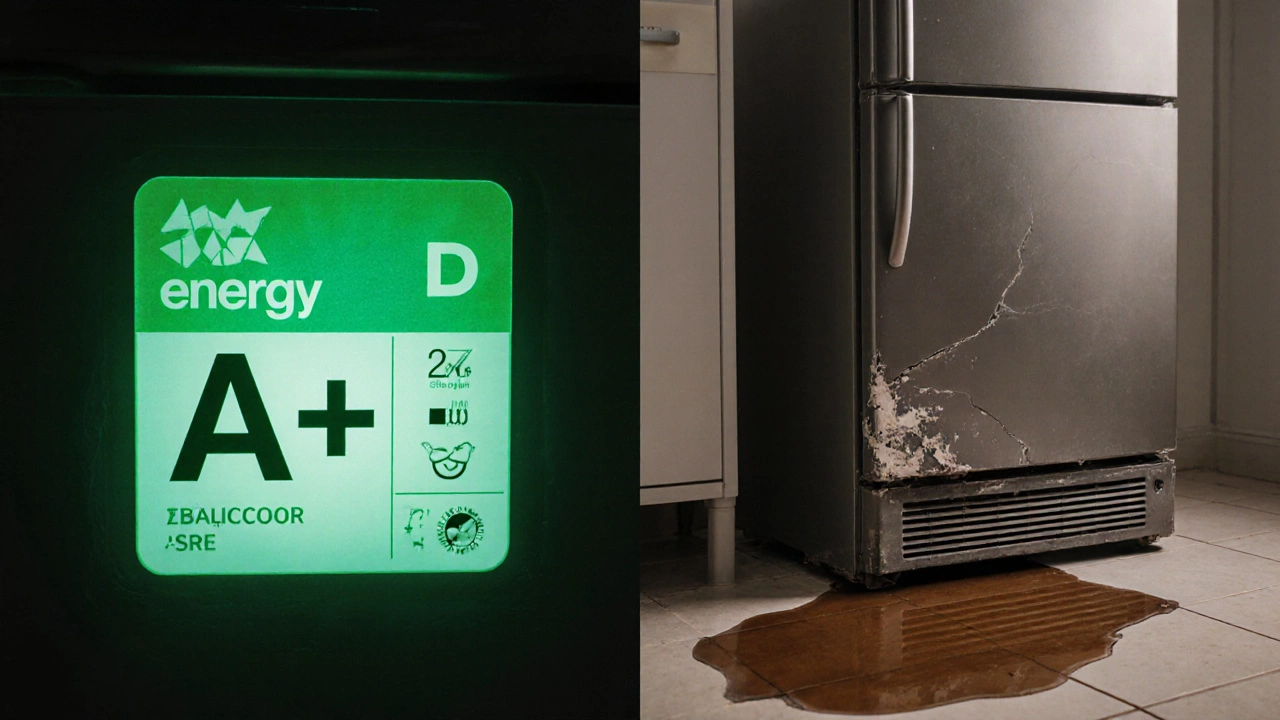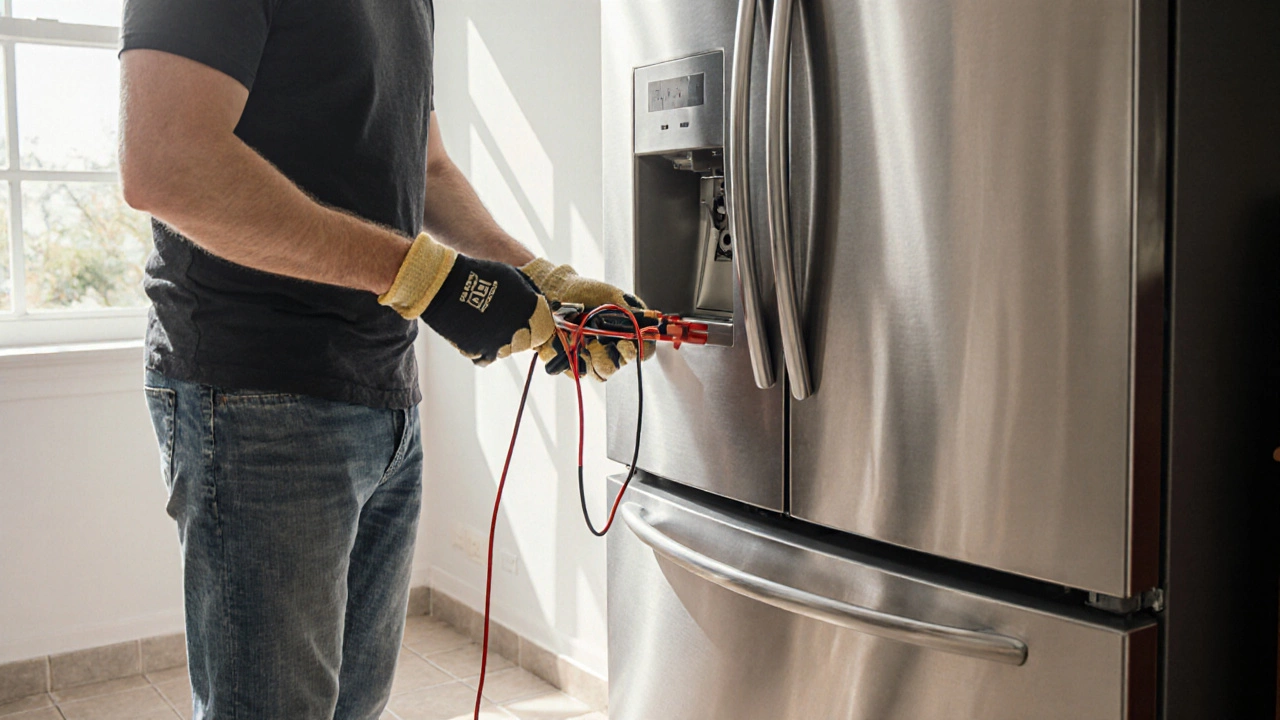
- 20 Nov 2025
- Gideon Thornton
- 0
Most people think their fridge is built to last forever. But if your food is warming up, ice is melting, or you’re hearing strange noises, something’s broken - and it’s probably not as rare as you think. In Bristol, where winters get damp and summers can spike above 30°C, fridges work harder than ever. And when they fail, it’s rarely a mystery. There are just a few things that break over and over again.
The Door Seal (Gasket) Is the Most Common Culprit
That rubber strip around your fridge door? It’s not just there to look neat. It’s your fridge’s first line of defense against warm air. Over time, it gets stiff, cracked, or pulls away from the frame. You won’t always see the damage. But if you’ve ever pulled open the door and felt a puff of cold air escape, that’s your seal failing.
Try the paper test: Put a £1 note halfway in the door and close it. If you can pull it out easily - without resistance - the seal is gone. This happens in over 60% of fridge repairs we see here in Bristol. It’s cheap to fix - a new gasket costs under £20 - but if you ignore it, your compressor runs non-stop. That kills your electricity bill and burns out the motor faster.
The Compressor Just Gives Up
The compressor is the heart of your fridge. It pumps refrigerant around the system to keep things cold. When it dies, your fridge goes from chilly to room temperature in hours. And it doesn’t always make a loud bang. Sometimes it just stops. No hum. No vibration. Nothing.
Why does it fail? Usually because the seal was already bad, forcing the compressor to work overtime. Or because the condenser coils are clogged with dust. In homes with pets or dusty kitchens, coils get blocked within 2-3 years. Clean them every six months with a vacuum brush. If the compressor is dead, replacing it costs £300-£500. Most people choose to replace the whole fridge instead.
The Thermostat Lies to You
It’s easy to blame the fridge when the temperature’s off. But sometimes, the thermostat - the little dial or digital sensor - is just wrong. You turn it to ‘4’, but the fridge stays at 12°C. That’s not a cooling problem. That’s a control failure.
Older fridges use mechanical thermostats that wear out. Newer ones have electronic sensors that can glitch. If your fridge runs constantly but still isn’t cold, check the actual temperature with a standalone thermometer. If it’s way off from the setting, the thermostat’s faulty. Replacement parts cost £40-£80. And it’s a simple swap if you’re handy. If you’re not, a technician can do it in under an hour.
The Drain Hole Gets Blocked
Every fridge has a tiny drain hole at the back of the freezer compartment. It lets meltwater escape to a pan underneath, where it evaporates. But food bits, ice chunks, or mold can clog it. When that happens, water pools at the bottom of the fridge or leaks onto the floor.
It’s not a cooling issue - but it’s annoying, and it can rot your shelves or ruin the floor. Clear it with a pipe cleaner or a bent wire hanger. Pour warm water down the hole to flush it out. Do this every few months, especially if you store veggies or frozen meals that drip. I’ve seen fridges last 15 years just because someone cleaned the drain once a year.

The Evaporator Fan Stops Spinning
Inside the freezer, there’s a small fan that blows cold air into the fridge compartment. If it stops, your fridge stays warm while the freezer still works. You’ll notice the freezer is icy, but the fridge is lukewarm. That’s the evaporator fan.
Ice buildup from a bad seal or clogged drain can freeze the fan blades. Or the motor just wears out. Unplug the fridge, remove the back panel in the freezer, and check if the fan spins freely. If it’s frozen, defrost the area. If it’s silent and won’t turn, you need a new fan. Parts cost £50-£90. This is one of the easiest fixes if you’re willing to get under the panels.
Condenser Coils Are Ignored Until It’s Too Late
Most people don’t know where their fridge’s condenser coils are. They’re usually at the back or bottom. They look like a metal grid. Their job? To release heat from the refrigerant. If they’re covered in dust, lint, or pet hair, the fridge can’t cool properly. It runs longer. It gets hotter. And eventually, it overheats and shuts down.
It’s not a broken part. It’s neglect. Clean them every six months. Use a vacuum with a brush attachment. Don’t use compressed air - it just pushes dust deeper. In homes with cats or long-haired dogs, clean them every three months. This simple habit can add 5-8 years to your fridge’s life.
When It’s Not Worth Fixing
Not every fridge problem needs a repair. If your fridge is over 10 years old and the compressor is dead, replacement is usually smarter. New fridges use 40% less energy than models from 2015. A £500 repair on a 12-year-old unit might save you £30 a year on bills. That’s 16 years to break even - and that’s if nothing else breaks.
Look at the energy label. If it’s rated D or below, it’s already costing you more than it should. New A++ models cost £400-£700. Many come with 2-year warranties. That’s better than paying £400 to fix a dying machine.

Quick Fixes You Can Try Today
- Check the door seal with the £1 note test
- Unplug the fridge for 10 minutes, then plug it back in - sometimes the control board resets
- Move items away from the back vents - airflow matters
- Use a thermometer to check actual temperature (should be 1-4°C)
- Clear the drain hole with warm water and a pipe cleaner
These won’t fix a broken compressor. But they’ll catch the small stuff before it becomes a £500 disaster.
What to Do If Your Fridge Is Already Dead
If your fridge isn’t cooling at all and none of the fixes help, don’t keep turning it on and off. That stresses the motor. Unplug it. Take a photo of the model number and energy label. Call a local repair service. Ask if they offer free diagnostics. Most will come out for £20-£40 and tell you if it’s worth fixing.
Or check with your local council. In Bristol, some recycling centres take old fridges for free and recycle the refrigerant properly. Don’t just leave it by the curb. It’s illegal and harmful to the environment.
Why is my fridge running all the time but not cold?
This usually means the door seal is broken, the condenser coils are dirty, or the evaporator fan isn’t working. Warm air leaks in, so the compressor runs non-stop trying to catch up - but it can’t cool properly. Check the seal first, then clean the coils. If that doesn’t help, the fan or thermostat may be faulty.
How long should a fridge last?
Most fridges last between 10 and 15 years. With regular maintenance - cleaning coils, checking seals, clearing drains - some last 20 years. But if you’re using a model from before 2010, it’s probably using twice as much electricity as a new one. Energy savings often make replacement cheaper than repairs after 10 years.
Can a fridge be re-gassed?
Technically yes, but it’s rarely a good idea. Refrigerant doesn’t just ‘run out’ - it leaks because of a damaged pipe or joint. Re-gassing without fixing the leak means it’ll leak again in weeks. Most technicians won’t do it unless they’ve found and sealed the leak. Even then, it’s expensive (£200+) and doesn’t fix worn parts. Replacement is often the smarter move.
Why is there ice in my fridge?
Ice inside the fridge (not the freezer) usually means the door seal is letting in moist air, or the temperature setting is too low. It can also happen if the drain hole is blocked and water can’t evaporate. Check the seal and clean the drain. Don’t set the fridge below 1°C - that invites frost.
Is it normal for a fridge to make clicking noises?
A single click when the compressor turns on or off is normal. That’s the relay switching. But if you hear rapid clicking every few seconds, the compressor is trying to start but failing. That’s a sign of a failing starter relay or compressor. Don’t ignore it - it’s the beginning of a bigger failure.
Next Steps: What to Do Now
Right now, unplug your fridge. Wait 5 minutes. Plug it back in. Listen. Does it hum normally? Then check the door seal with a pound note. Look behind the fridge - are the coils dusty? Open the freezer and see if the fan spins. Clear the drain hole with warm water.
If all that sounds like too much, take a photo of your fridge’s model number and search online for common faults. Most manufacturers list known issues. Or call a local repairer. Ask if they offer a free diagnostic. Don’t waste money on parts until you know what’s broken.
Your fridge isn’t magic. It’s a machine. And like any machine, it needs a little care. Fix the small things early, and you’ll avoid the big, expensive failures.


